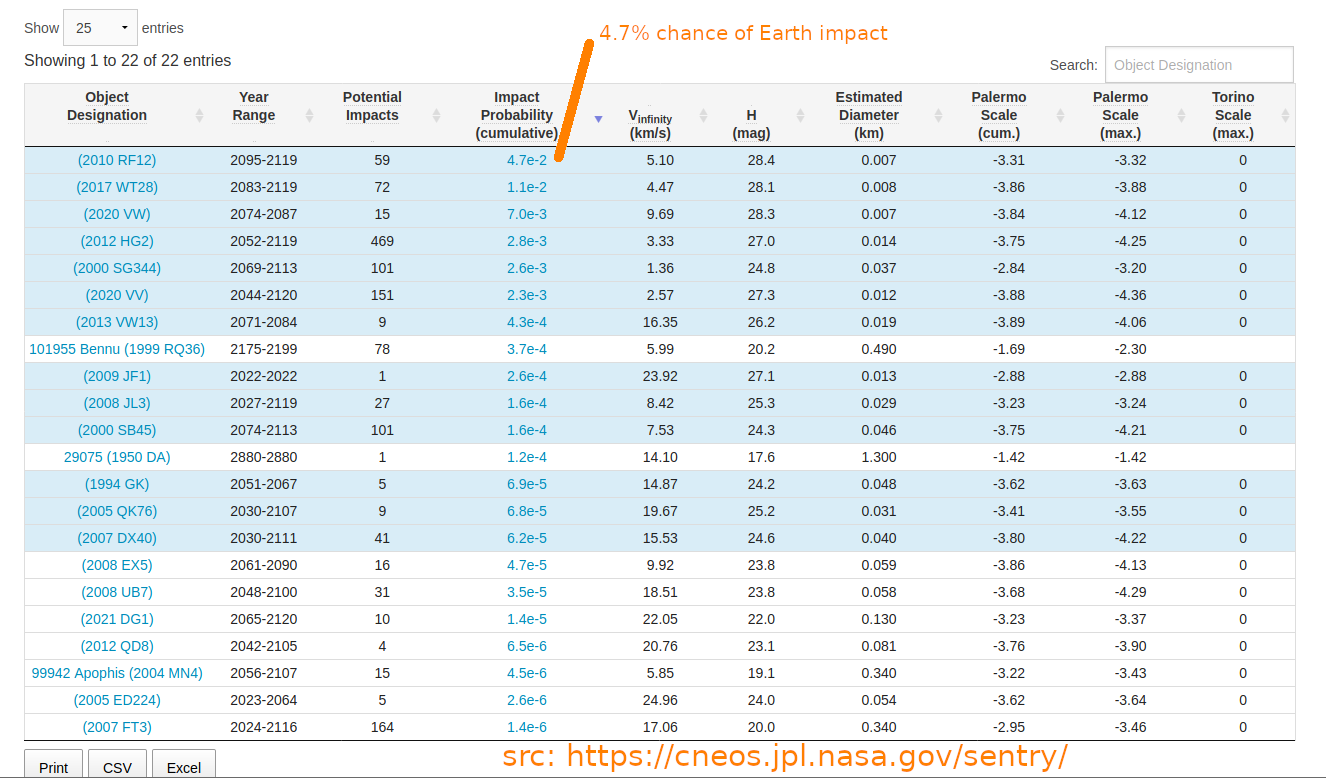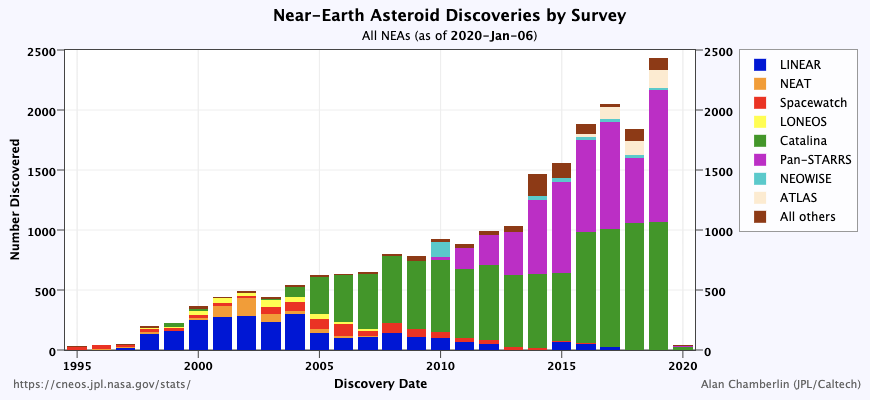Avoid CO2 use the Fusion Reactor in the Sky
(if the 2 is pronanced German than it even rhymes)
as a lot of fossil fuel is (still in 2021!) used to produce electrictiy, it is possible and recommended to set boinc client to only compute during daytime (when there is the highest %percentage% of solar electrictiy in the grid)
a (ever mutating Corona)Virus is the smallest possible threat to mankind… the literary biggest threat are: asteroids / meteors
as the user might now, there is NOTHING absolutely NOTHING the Galliers feared, except that… the heaven could fall on their heads.
“be aware of the enemy that comes out of the sun!”
is a old air-plane-fighter saying, to warn fighter-pilots that an attacker could come “out of the sun” thus the sun blinding the pilot and thus the attacker can attack undetected
same has been true for the Chelyabinsk meteor
- “meteoroid was too small for the survey telescopes and came at us out of the Sun” (src: 2013 blogs.nasa.gov) #wtf? X-D thought u guys have advanced radar in orbit or something…
- “The object was undetected before its atmospheric entry, in part because its radiant (source direction) was close to the Sun.” (src)
- “This material is dark, and not very reflective, which makes it difficult to spot out in outer space, especially if the object is bus or house size.”something…
- “The best asteroid survey telescopes have a magnitude limit of about +24” (so best asteroid survey telescopes suck!)
- “Note that, even with very large telescopes, the meteoroid would not have been visible until a mere 2 hours (135,000 km from Earth) before impact — very little time to sound a warning” (src)
- that would require (next time) very very fast reaction time X-D and very fast rockets to push something like this away into safer orbits
sounds catastrophic
and they were RIGHT!
When Chelyabinsk (20m (66ft) in diameter) meteor hit the earth it released “26 to 33 times as much energy as that released from the atomic bomb detonated at Hiroshima,[9]” (“400–500 kilotons of TNT“) (src)
“In 2016, a NASA scientist warned that the Earth is unprepared for such an event.[1]” (src)
“Its explosion created panic among local residents, and about 1,500 people were injured”
“Humanity has the skills and know-how to deflect a killer asteroid of virtually any size, as long as the incoming space rock is spotted with enough lead time, experts say.” (src)
-
early detection critical!
- “In 1998, NASA formally embraced the goal of finding and cataloging, by 2008, 90% of all near-Earth objects (NEOs) with diameters of 1 km or larger that could represent a collision risk to Earth.
- The 1 km diameter metric was chosen after considerable study indicated that an impact of an object smaller than 1 km could cause significant local or regional damage but is unlikely to cause a worldwide catastrophe.[20]“
- “The impact of an object much larger than 1 km diameter could well result in worldwide damage up to, and potentially including, extinction of the human species.” (src)
-
push it away with many rockets, don’t nuke it
- mankind “could even nudge off course a 6-mile-wide (10 kilometers) behemoth like the one that dispatched the dinosaurs 65 million years ago. We’d likely have to slam multiple spacecraft into a gigantic asteroid over a period of several decades to do the job, but the high stakes would motivate such a strong and sustained response, researchers say.
“If you can hit it with a kinetic impactor, you can hit it with 10 or 100 of them,” former NASA astronaut Ed Lu, chairman and CEO of the nonprofit B612 Foundation, which is devoted to protecting Earth against asteroid strikes, said during a news conference last month. [Photos: Potentially Dangerous Asteroids Up Close]
“And I would submit to you that if we were finding an asteroid that’s going to wipe out all life on Earth, or the majority of life on Earth, that funding is not an issue for launching 100 of them,” Lu added.” (src)
- mankind “could even nudge off course a 6-mile-wide (10 kilometers) behemoth like the one that dispatched the dinosaurs 65 million years ago. We’d likely have to slam multiple spacecraft into a gigantic asteroid over a period of several decades to do the job, but the high stakes would motivate such a strong and sustained response, researchers say.
“in March 2019, scientists reported that asteroids may be much more difficult to destroy than thought earlier.[8][9] In addition, an asteroid may reassemble itself due to gravity after being disrupted.[10]” (src)
if mankind does not want to end up like the dinosaurs the UN should fund program to detect and divert dangerous objects that could hit earth
there are many… many many near earth objects… and just as regular checking the news… NASA & Co should check the sky, for anything that could become potential dangerous to earth.
All Life forms on earth should regularly check NASA’s website https://cneos.jpl.nasa.gov/sentry/ (RSS feed)
if anything potential dangerous could fall from the sky… on our heads.
- the meteor-asteroid that killed the dinosaurs was 10-15km in diameter (src) and caused a crater of 150 km (came down NEAR the golf of Mexico, but did not create the golf of Mexico (that’s what they say)
- even if a city could get killed by the impact of a larger meteor instantly
- the rest of mankind not directly hit will suffer severely because of all the dust in the atmosphere cooling climate so massively -> ice age might begin (massive bad harvests around the planet, causing mass starvation, also completely destroying the hope for mankind to power itself solar for centuries to come)
School Bus-Size Asteroid to Safely Zoom Past Earth
2020-09-22
A small near-Earth asteroid (or NEA) will briefly visit Earth’s neighborhood on Thursday, Sept. 24, zooming past at a distance of about 13,000 miles (22,000 kilometers) above our planet’s surface. The asteroid will make its close approach below the ring of geostationary satellites orbiting about 22,000 miles (36,000 kilometers) away from Earth.
so that…
mankind won’t end up like…
asteroids, meteors, comets, what is the difference?

WISE Infrared View of Comet Siding Spring https://en.wikipedia.org/wiki/File:Comet_Siding_Spring.jpg
- they are all objects that fly around and through our solar system
- asteroids are smaller than a planet, but larger than pebble-size objects NASA calls meteoroids
- also: asteroids become meteors when they enter Earth’s atmosphere (usually) breaking up and creating a streak of light in the sky (“shooting star”)
- comets orbit the sun and are (usually) made up of ice
“time is estimated at around 00:20 ACST (19.05.2019 at 14:50 UT)” (src: imo.net)
even with pretty good sound (GoPro Hero 3? :)… nope different model.)
https://www.imo.net/large-weekend-asteroid-over-australia-19-may-2019/
-
meteors / asteroids
-
imho UN needs to unite all nations to invest into meteor-observing and diversion (rockets could push it into safe(er) orbit) program which means:
- detect it early – as early as possible (it is catastrophic that right now mankind does not even know exactly how big this C/2019 Y4 (ATLAS) meteor is? (no it will not hit us, but “several kilometers” is a NOT a “precise” number X-D)
- here is the toplist of possible-to-impact meteors: https://cneos.jpl.nasa.gov/sentry/
- top of the probability list
- 1) is this sucker: (2010 RF12)https://ssd.jpl.nasa.gov/sbdb.cgi?sstr=2010%20RF12;old=0;orb=1;cov=0;log=0;cad=0#elem
- Alternate Representations for Impact Probability = 4.9e-2
4.9% chance of Earth impact
1 in 20 odds of impact
95.1% chance the asteroid will miss the Earth - date of impact: somewhere after 2095
- Dimensions ~7m (23 feet)
- Mass: 5.00E+05 = 500.000kg, 500t, okay? wow. (src)
- Alternate Representations for Impact Probability = 4.9e-2
- 2) (2018 VP1)
- … so (almost) no worries, but that DOES NOT MEAN, we, mankind, can standby and play stupid, like “funding this new stadion is just way more sexy voter wise”
- comparison to the meteor / asteroid that killed the Dinosaurs:
- Chicxulub impactor, 11 to 81 kilometres (7 to 50 mi) (src: Wiki)
- Kinetic Energy: 1.3e24 J to 5.8e25 J. (1.300.000.000.000.000GJ to 58.000.000.000.000.000GJ) (taking the median value of 29.650.000.000GJ = 29.650.000.000.000 GWh of electricity)
- Diameter: 10.6 km to 80.9 km.” (src: https://arxiv.org/abs/1403.6391)
- Mass: 1.0e15 kg to 4.6e17 kg (1.000.000.000.000t – 460.000.000.000.000t) (this thing was truly massive)
-
“most all meteoroids that enter the atmosphere make it to the ground, in the form of microscopic dust” (src) interesting.
2013 over Russia: pretty real and captured on many car cams:
“(17 meters) space rock exploded in the atmosphere over the Russian city of Chelyabinsk, injuring more than 1,000 people” (src) (mostly because people were standing at the (closed) windows and the shock wave burst the windows into sharp pieces…
also interesting: “secret ocean inside earth”
Links:
https://www.space.com/23530-killer-asteroid-deflection-saving-humanity.html
https://en.wikipedia.org/wiki/NEOWISE
https://en.wikipedia.org/wiki/Asteroid_impact_avoidance
https://dwaves.de/2015/02/26/grid-computing-boinc-project-asteroidshome-from-czech-republik/
https://www.livescience.com/46292-hidden-ocean-locked-in-earth-mantle.html
https://www.nasa.gov/planetarydefense
For asteroid and comet news and updates, follow @AsteroidWatch on Twitter:
liked this article?
- only together we can create a truly free world
- plz support dwaves to keep it up & running!
- (yes the info on the internet is (mostly) free but beer is still not free (still have to work on that))
- really really hate advertisement
- contribute: whenever a solution was found, blog about it for others to find!
- talk about, recommend & link to this blog and articles
- thanks to all who contribute!














